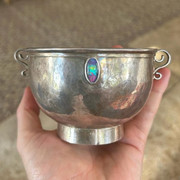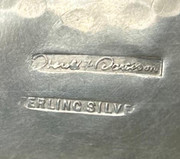Page 1 of 1
Mystery American arts and craft maker?
Posted: Wed Jul 05, 2023 3:49 pm
by Peartree
Hi, does anyone recognise this maker? I think American, likely c 1910, arts and crafts. Possibly Boston School. It looks like a partnership of a name I cannot identify and Davison. Please see images. Thank you Anthony


Re: Mystery American arts and craft maker?
Posted: Thu Jul 06, 2023 3:06 am
by Peartree
I think it is possible the maker / signature is Harrold F Davison? So not two surnames. All thoughts welcome.
Re: Mystery American arts and craft maker?
Posted: Thu Jul 06, 2023 2:26 pm
by Aguest
::::: Something about the general look of the "STERLING SILVER" stamp reminds me of the "STERLING SILVER" stamp that I've seen on Australian pieces. :::::
::::: I've tried some Australian Arts & Crafts makers with no luck so far. :::::::
::::: I do understand the Boston School comparison, however, that's immediately what I thought as well upon first seeing the bowl with the dichroic glass and the shape of the handles. ::::::
::::: Hard to believe I can't find a "DAVISON" surname in American Arts & Crafts silver, but it's a dead end so far, it clearly says "DAVISON" even if the first name is a little hard to read, that surname is so obviously "DAVISON" I mean what else could it be? ::::::
Re: Mystery American arts and craft maker?
Posted: Thu Jul 06, 2023 4:23 pm
by Aguest

:::: The raised letters within the flat background of the cartouche & also the way the middle slash of the letter "E" looks like a tiny triangle. :::::
:::: If you browse through the directory of Australian Silversmiths, you will see a similar "STERLING SILVER" stamp used here and there, I'm not saying the exact same punch was shared between Australian silversmiths, but there must have been a certain tradition of the way "STERLING SILVER" punches were designed as master silversmiths trained apprentices who became masters and trained apprentices and so on and so forth..... :::::::
Re: Mystery American arts and craft maker?
Posted: Fri Jul 07, 2023 7:46 am
by Peartree
Thank you. I will research Australian too.
Re: Mystery American arts and craft maker?
Posted: Sun Jul 09, 2023 6:58 am
by Peartree
I am now pretty sure the signature is Harold F Sargison, which would make this bowl a very early piece by Sargisom who went on to estsblish the famous Yobart firm “Sargisons”. If anyone can confirm this that wouod be great. Thank you
Re: Mystery American arts and craft maker?
Posted: Tue Jul 11, 2023 9:16 pm
by Aguest
:::::::: I did look through Sargison (Hobart, Tasmania) and just based on form alone it was similar, but I never could find a signature like the signature on your example. ::::: Mentioned below are the National Gallery of Australia and the Powerhouse Museum which may have objects which bear a signature like the signature on your example. :::::: The signature really fooled me, I couldn't understand it at all. :::::
HAROLD FRANCIS SARGISON
::::::::: Harold Francis Sargison (1885-1983), silversmith and clockmaker, was born on 10 October 1885 in Hobart, third of four children of Tasmanian-born parents Francis Augustus Sargison, an engineering pattern-maker, and his wife Ann Eleanor, née Evans. Harold attended Battery Point Model School and in 1902 was apprenticed for five years to a silversmith, Joseph William Quarmby. Excited to receive his first pay packet, Harold ran home and presented five shillings to his mother, an action indicative of the generosity of spirit that was to be a trait of his personality. He went into partnership with George Miller in a watchmaker and jeweller’s shop at 31 Murray Street, bought the business in 1919, and moved it in 1922 to 21 Elizabeth Street, where he developed a reputation as a fine craftsman. On 15 March 1924 at St David’s Cathedral he married with Church of England rites Doris Winsbury Ivey (d.1974), a clerk.
Exhibiting regularly in the 1920s with the Arts and Crafts Society of Tasmania, Sargison was influenced by its president, the architect and designer Alan Walker. In 1932 he made the elaborate gold monstrance, adorned with precious stones, designed by Walker for St Mary’s Cathedral, Hobart. Other significant works included a military trophy, now held by the Military Museum of Tasmania, Anglesea Barracks, a grandfather clock, shown at the 1931 arts and crafts exhibition in Hobart, the lord mayor of Hobart’s chain of office and the mace for the State parliament. He was well known for his jointless metal jugs, decorated with gum leaves and gumnuts. A member of the British Horological Institute, Sargison maintained the clocks at Government House in Hobart for four decades. In 1966 he moved his shop to premises in Liverpool Street.
Sargison was tall, lean and lantern-jawed; an early riser, he was a hard worker with apparently boundless energy and with the ability to improvise when necessary. He was a warm family man, who loved music. Affectionately known as ‘Sargie’, he had joined the Tasmanian Field Naturalists’ Club in 1914. On the committee from 1934 to 1958, he organised the club’s Easter camps for twenty years and became a life member in 1948. He was a member of the Royal Society of Tasmania and a board member of St Ann’s Homes. A long-serving member of the Rotary Club of Hobart, he was a Paul Harris fellow in 1980. He retired in his nineties, after supervising the making of a set of sterling silver serving spoons, commissioned in 1981 as a wedding gift from Tasmanians for Prince Charles and Lady Diana Spencer. Survived by his two daughters and a son, he died on 22 December 1983 in Hobart, and was cremated. His work is represented in public collections, including the National Gallery of Australia, Canberra, and the Powerhouse Museum, Sydney. :::::::::::::::
